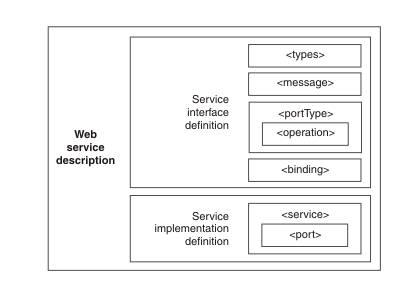A web service description is a document by which the service provider communicates the specifications for starting the web service to the service requester. Web service descriptions are expressed in the XML application known as Web Service Description Language (WSDL).
The service description describes the web service in such a way as to minimize the amount of shared knowledge and customized programming that is needed to ensure communication between the service provider and the service requester. For example, neither the requester nor the provider needs to be aware of the platform on which the other runs, nor of the programming language in which the other is written.
A service description can conform to either the WSDL 1.1 or WSDL 2.0 specification. Each has differences in both the terminology and major elements that can be included in the service description. The following information uses WSDL 1.1 terminology and elements to explain the purpose of the service description.
- An abstract service interface definition that describes the interfaces of the service and makes it possible to write programs that implement and start the service.
- A concrete service implementation definition that describes the location on the network (or endpoint) of the web service of the provider and other implementation-specific details. It enables a service requester to connect to the service provider.
- <types>
- A container for data type definitions using some type system (such as XML Schema). Defines the data types used within the message. The <types> element is not required when all messages consist of simple data types.
- <message>
- Specifies which XML data types are used to define the input and output parameters of an operation.
- <portType>
- Defines the set of operations supported by one or more endpoints. Within a <portType> element, each operation is described by an <operation> element.
- <operation>
- Specifies which XML messages can appear in the input and output data flows. An operation is comparable with a method signature in a programming language.
- <binding>
- Describes the protocol, data format, security, and other attributes for a particular <portType> element.
- <port>
- Specifies the network address of an endpoint and associates it with a <binding> element.
- <service>
- Defines the web service as a collection of related endpoints. A <service> element contains one or more <port> elements.

- The standards body provides a service interface definition, containing
the following elements:
- <types>
- <message>
- <portType>
- <binding
- A service provider wanting to offer an implementation of the service
provides a service implementation definition, containing the following
elements:
- <port>
- <service>
